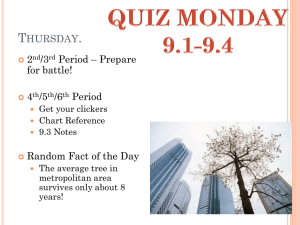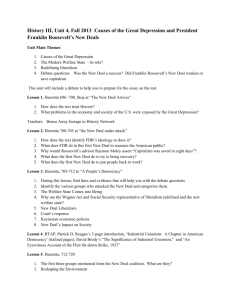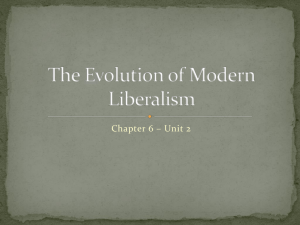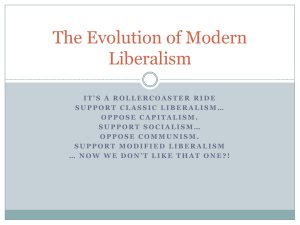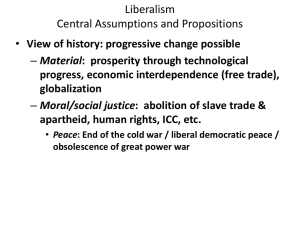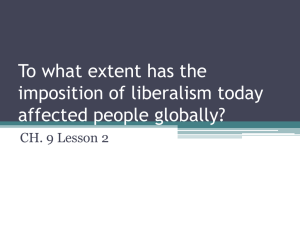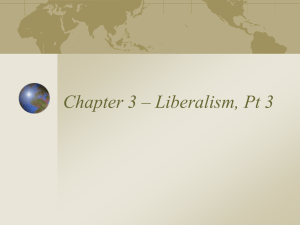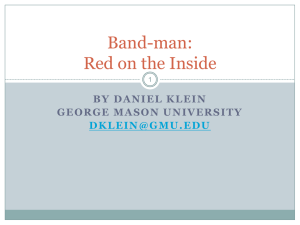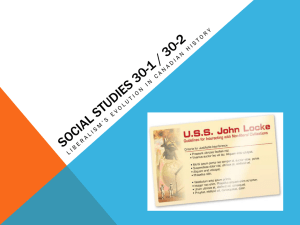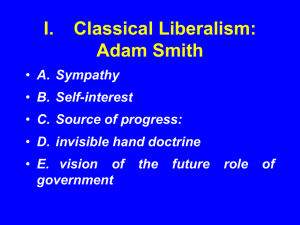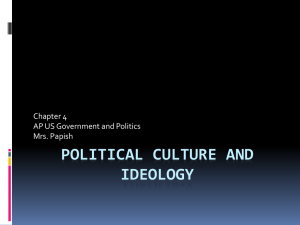Power Point - wchs ss30-1
advertisement
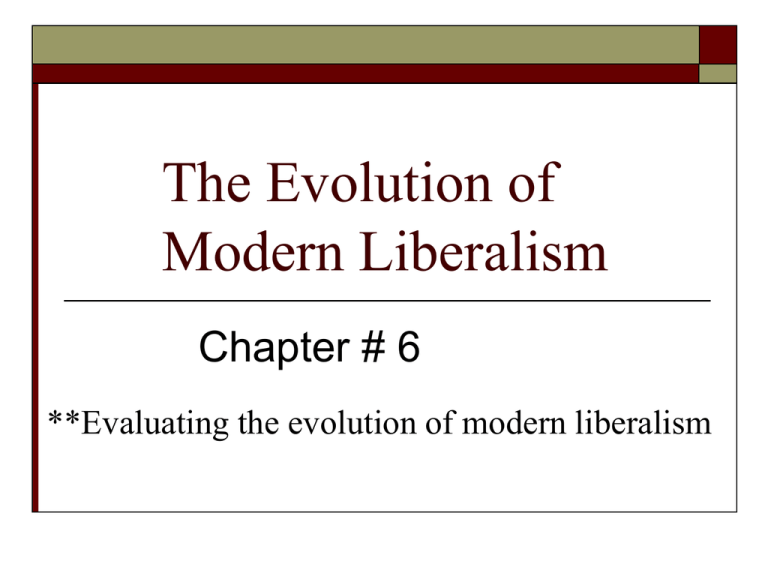
The Evolution of Modern Liberalism Chapter # 6 **Evaluating the evolution of modern liberalism Chapter # 6 Vocabulary Consumerism Income disparity Inflation Monopoly Social programs Trickle-down economics Welfare state Modern American liberalism is a form of liberalism that arose from progressive ideals such as Theodore Roosevelt's New Nationalism, and Franklin D. Roosevelt's New Deal. Modern American liberalism is a combination of social liberalism, social progressivism, support for a welfare state and a mixed economy. Keynesian economics play an influential role in the philosophy. It is often associated with the Democratic Party. Liberals support freedom of speech and freedom of religion as well as government entitlements such as health care and education. :the central premise that individual freedom can only exist where it is protected by a strong democratically elected government that has an active role in society and the economy. ( summarize this slide) Homestead Strike The failure of the strike was the beginning of a long decline for the steelworkers union. Carnegie steel plants would employ only non-union workers for the next 40 years. skip Read p. 196-97 Economics and the Principles of Liberalism in North America skip Taking an Economic Practice Opinion Poll Rm 6.1 Question 1-20 Survey 4 other students and identify the three questions with most agreement and the three questions where you opposed almost unanimously. Read p.198-99 skip The Jungle is a 1906 novel written by author and socialist journalist Upton Sinclair. Sinclair wrote this novel to highlight the plight of the working class and to remove from obscurity the corruption of the American meatpacking industry during the early 20th century. The novel depicts in harsh tones the poverty, absence of social programs, unpleasant living and working conditions, and hopelessness prevalent among the working class, which is contrasted with the deeply rooted corruption on the part of those in power. The sad state of turn-of-the-century labor is placed front and center for the American public to see, suggesting that something needed to be changed to get rid of American "wage slavery". The Progressive Era (Series: America in the 20th Century) http://www.learnalberta.ca/content/aeve/movi eLauncher.html?movie=smil/progressive_era _cc.mov Roosevelt’s Progressivism Gave the public a “square deal” Preventing large companies from abusing their control over the marketplace. Why was Standard Oil on Roosevelt's hit list? Notes on Taft and the Sherman Anti-Trust Act Notes on Alphonse Desjardins and Credit Unions How did these reforms help Americans? Reforms Limited to some extent the classical liberal freedoms and principles of the marketplace. Reforms prevented powerful entities from abusing the rights and freedoms of less influential organizations and individuals. Credit Unions: profit-sharing operation went against classical liberal principles. Evolution of modern liberalism Roaring Twenties Roaring Twenties is a phrase used to describe the 1920s, principally in North America, that emphasizes the period's social, artistic, and cultural dynamism. Everyone would have a chance at attaining prosperity The Wall Street Crash of 1929 served to punctuate the end of the era, as The Great Depression set in. Radio Prohibition Talkies TV Women get the vote Political cartoon of 1919 depicting a "European anarchist" attempting to destroy the Statue of Liberty. Represents Liberal Democracy The term "Red Scare" has been retroactively applied to two distinct periods of strong anti-Communism in United States history: first from 1917 to 1920, and second from the late 1940s through the late 1950s. These periods were characterized by heightened suspicion of Communists and other radicals, and the fear of widespread infiltration of Communists in U.S. government. The first Red Scare 150,000 anarchists or communists in USA in 1920 Seattle docks were idled by a strike race riots, police strike in major American cities contributed to the perception that support for Socialism and communism in America was growing. Produced an atmosphere of political conservatism. (ultimately lead to a resistance to change.) Harding and Coolidge p.202-03 What was Harding’s platform of a “return to normalcy”? How were the tax reductions and subsidies by Coolidge a reflection of classical liberalism? How do the developments of economic prosperity, mass production, mass marketing and consumerism reflect the values of classical liberalism? Tax reductions and reduced subsidies Lessens the level of government intervention Strengthens the role of the market. Economic prosperity and Consumerism Henry Ford and mass production ( produce large volumes of a product) Practiced Welfare capitalism : minimum wage and a 40 hour work week. Better wages would encourage them to buy more goods and services Consumerism increased during the 1920’s Radio ,film, telephones and refrigeration encouraged consumerism. The Stock Market Crash of 1929 P.206-07 Notes Define Bank runs Social Effects of the Depression Notes 207-08 The 1930’s and the Great Depression The Election of 1932 Americans blamed President Hoover for the country’s economic woes. Franklin Delano Roosevelt won the Democratic Party’s nomination. Roosevelt promised relief for the poor and more public works programs to provide jobs. He attacked Hoover and the Republicans for their response to the Great Depression. Long-lasting influence on liberal democratic governments. ( government intervention) II. plans for I. Relief for economic the unemployed Recovery The New Deal had three major goals: Evolution of modern liberalism III. Reforms to prevent another depression Franklin Roosevelt as President Banking Crisis • Temporarily closed all the nation’s banks to stop panic and large-scale withdrawals Hundred Days • Roosevelt pushed Congress to put most of his New Deal into practice. • The New Deal promised relief, recovery and reforms. Trouble for the New Deal Radical Reactions to the New Deal • Believed the New Deal did not go far enough in reforming the economy • Wanted a complete overhaul of capitalism Conservative Reactions to the New Deal • Attacked the New Deal as a radical break with traditional American ideals RM. 6.2 High light a document Economic Downturn of 1937 The Nation’s Economy • Roosevelt had hoped to cut back on government spending, for he feared the growing federal budget deficit. • As unemployment rose during 1937 and 1938, the government spent large sums of money to help the unemployed. Economic Theory • British economist John Maynard Keynes argued that deficit spending was needed during a depression. Write a paragraph in a word document In what ways did Roosevelt’s New Deal reject or reflect the principles of Liberalism? The Dark Years 1929-1939 in Canada http://www.learnalberta.ca/content/aeve/movi eLauncher.html?movie=smil/dark_episode_1 _ana_cc.mov Government Responses to the Depression in Canada Prime Minister Bennett Relief camps Believed that laissez-faire policies would lead the country out of the crisis Created the Bank of Canada: took control of the money supply. Bennett's New Deal Bennett's "New Deal" promised a more progressive taxation system, a maximum work week, a minimum wage, closer regulation of working conditions, unemployment insurance, health and accident insurance, a revised old-age pension and agricultural support programs. Nevertheless, Bennett lost the October 1935 general election. ( evolution of modern liberalism) Prime Minister Mackenzie King Created many social programs ( modern welfare state ) Unemployed built airports Established TransCanada airlines National Harbours board Created the CBC Crown Corporations And Social Programs Bank of Canada National film board Unemployment Insurance Family allowance National Housing Act ( low income housing) ** the evolution of modern liberalism The Ebb and Flow of Economic Liberalism Since the Second World war Canada: strengthened social programs Public health Care Old Age Pension Foreign Investment Review agency CRTC: An independent agency responsible for regulating broadcasting and telecommunications systems in Canada Economic Crisis of the 1970’s USA wanted their currency to “float”; not be tied to the gold standard Other countries followed suit, and a period of inflation followed. Classical Liberalism: currencies would trade freely in an open market. Yom Kippur War 1973 1973 Arab-Israeli War and the Fourth Arab-Israeli War between Israel and a coalition of Arab states backing Egypt and Syria. Egypt and Syria respectively crossed the cease-fire lines in the Sinai and the Golan Heights, which had been captured and occupied by Israel since the 1967 Six-Day War. Opec:( organization of petroleum exporting countries) imposed a 5 month embargo on the USA who has always back the state of Israel. Opec: reduced production causing an increase in price and added to the inflation as a recession occurred as countries that cut back in economic production. Stagflation: a recession and high inflation as the same time. Yom Kippur War 1973 Stagflation Cost of social programs go up as the recession causes more unemployment. Governments are collecting less taxes from big business and the average citizens Monetarism: Friedman and Hayek Try to undo the interventionist policies of previous governments (Klein and Stephen Harper) One monetarist policy conclusion is the rejection of fiscal policy in favor of a “monetary rule.” ( interest rates) http://www.youtube.com/watch?v=Q277sXW0Z2k&feature=related Moore schooled by Friedman over economics http://www.youtube.com/watch?v=cD0dmRJ0oWg&feature=related http://independence4wales.com/2012/milton-friedman-the-road-to-serfdom (very good) Supply Side Economics Supply-side emphasizes the importance of tax cuts and business incentives in encouraging economic growth, in the belief that businesses and individuals will use their tax savings to create new businesses which in turn will increase productivity, employment. Reaganomics Tax cuts primarily for corporations and the wealthy government spending cuts on social services deregulation of the economy Thatcherism: wide scale privatization emphasis on individual and self-help (classical Liberalism) reduced the power of the labour unions ( unions are seen as a threat to the free market system) http://www.youtube.com/watch?v=z5CCRI1vdwE&feature=related Reaganomics Reagan’s plan for tax and spending cuts Two goals Reduce taxes to stimulate economic growth Cut the federal budget Based on supply-side economics A theory that says breaks for businesses will increase supply of goods and services, aiding the economy Thatcherism http://www.youtube.com/watch?v=40NVkfbaMo4 Pause and Reflect p. 224 In what way does this example represent a middle ground between laissez-faire economics and social justice? Democratic Socialism It is characterized by central planning, nationalization and a comprehensive social welfare programs. ( universality ) Legislative reforms Sweden is the modern “ Social Welfare State”. Public vs Private Industries Public Ownership 25% of the forest industry 50% of the hydro 85% of the iron ore 95% of the railroads The telephone systems Private Ownership 90% of workers work in private firms Large multinationals exist such as Volvo, Saab. P.226 Life is a Smorgasbord http://www.ifitweremyhome.com/compare/US/SE Sweden United States P. 228 Comparative Scale Draw figure 6-16 into your notes Review points Economic Liberalism and the Global Economy Today There is the recognition that governments do indeed have a role to play in furthering the principles of modern liberalism ( domestically as well as internationally) We have begun to question the unregulated free market Bailout of industries and the regulation of banks in the USA. The ebb and flow of liberalism seems to flowing towards the left ( greater role of government.) Welfare Capitalism Combination of traditional free market principles mixed with laws or practices of a welfare state Provides a safety net for individuals living & working in society. Min. wage, working day, employment insurance Rationale traditional liberal economic theory would suggest workers are at a sever disadvantage compared to companies Welfare State Completely provides for the welfare or wellbeing of its citizens (physical, social) Greater economic equality (minimum standard of living) Education healthcare, employment insurance, price and wage controls, public transportation, child care, Some paid by taxes other insurance programs (temporary or permanent) Heavily taxed middle class and upper-class Difficulties Creating an efficient system Rationing of goods and services (dependence) Lack of motivation Resentment by those who work and have to pay heavy taxes to support those who do not work. Fiscal Policy Government’s use of taxing and spending to regulate and influence the economy. Governments use of spending and taxes to influence growth or decline the business cycle. Weak economy deficit spending Strong economy raise taxes Keynesian policies Monetary Policies Government regulation of the supply of money to influence the economy. When the economy is slowing down interest rates are lowered to stimulate borrowing and improve the economy (increasing the amount of money available) When the economy is strong / growing (inflation) interest rates are increased to reduce borrowing and slow down economic growth. Milton Friedman supporter of monetarism. Interesting article on Reganomics http://distributism.blogspot.com/2007/07/myt h-of-reaganomics.html
